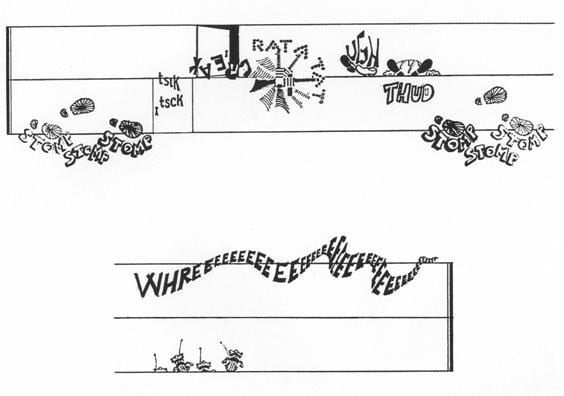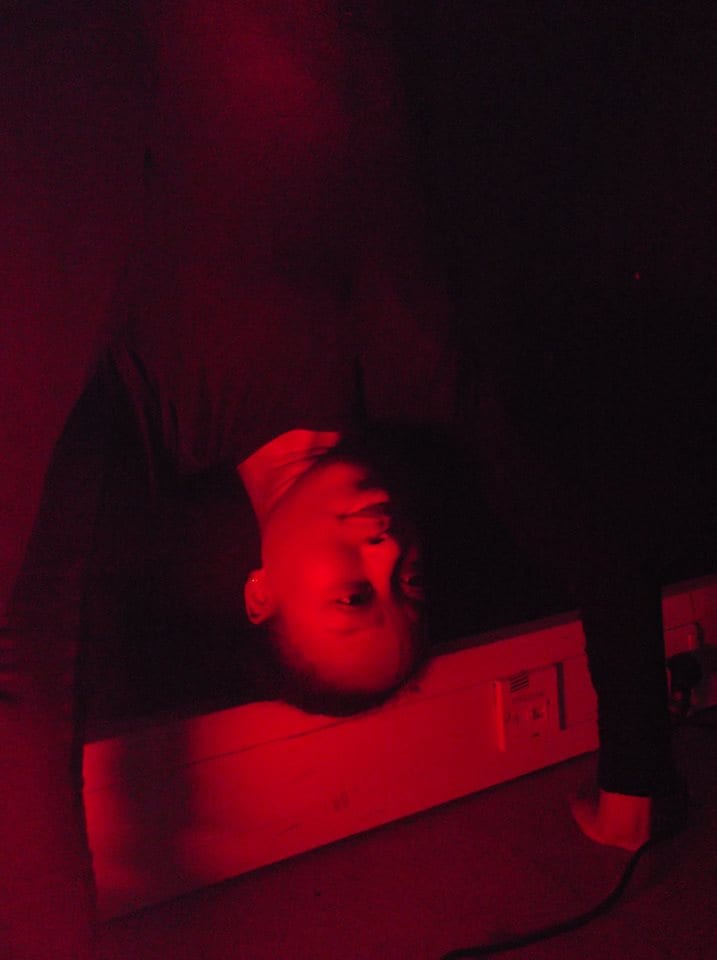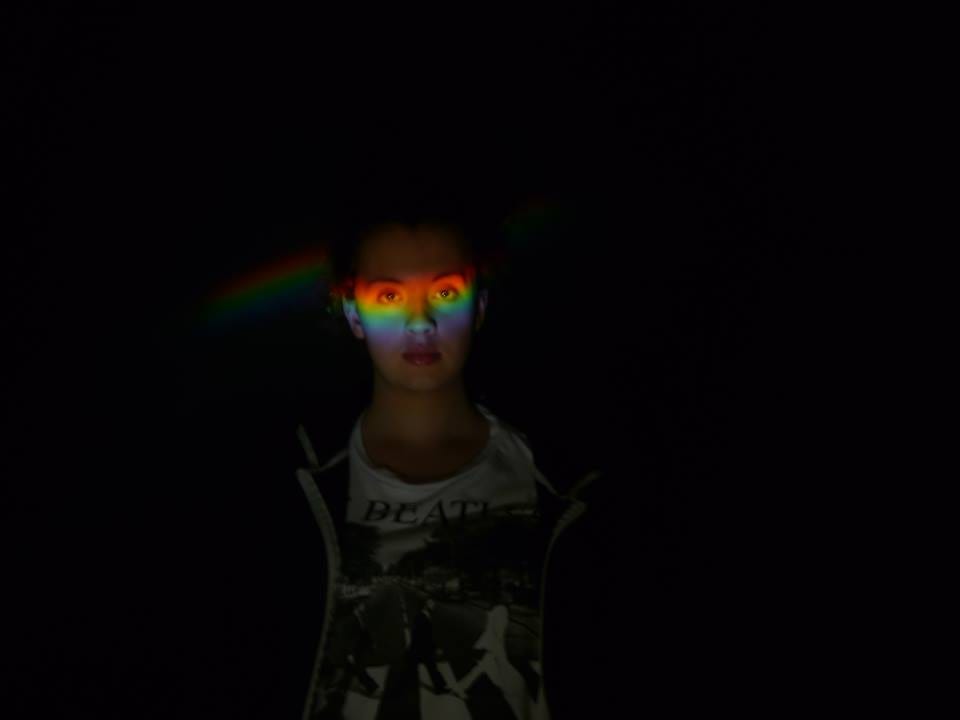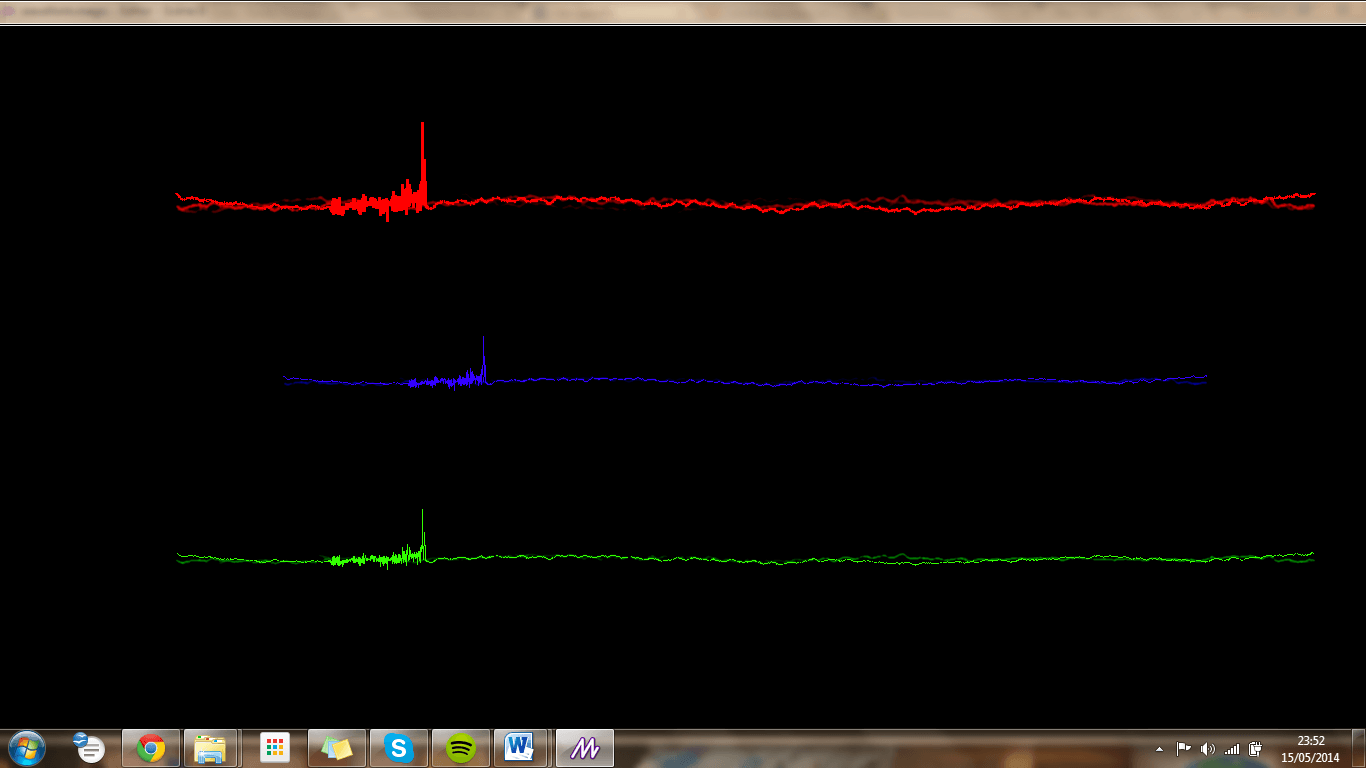Our final performance was named Dispersion; this means “the separation of white light into colours or of any radiation according to wavelength.” (Oxford English Dictionary, 2012, 204) Which takes the form of the Newtonian theories that we are focusing on during our performance, but our piece as a whole also lets the audience disperse as they please, whether that be around the room, or to come and go. But also the light used in our performance, leaving the staging simple meant that some areas of the performance space were left in complete darkness, whilst others were filled with overspill light or direct light. Dispersion took place in the LPAC, but will also feature at The Gravity Fields festival 2014. The performance took place on the 10th May 2014, and lasted for three and a half hours, the durational piece allowed the audience to come and go as they please, and the room was split into two sections to give the audience a sense of exploration when moving through our performance, as there was no one to guide them around, they explored for themselves.
Our performance was originally based around the ideas of retail, we were given the site of four disused shops in Grantham, we explored shops and focused on the things you do not normally observe when shopping, this lead us into exploring the use of light. As part of our brief for gravity field’s festival we were given different topics that we could focus on, these topics focused on science and so our ideas adapted to a more scientific based performance. These topics featured around the ideas of Isaac Newton, one of the world’s most famous scientists born and raised in Grantham. The topic we chose to focus on featured the ideas of light, optics and electricity.
Our performance developed into a physical performance of light and sound, after the feedback we were given on our performance, we took it back to the roots of light and sound and the body, exploring the ideas of the connection between light and sound, how light reacts to sound, using research we collected about notes of the scale correlating with the colours of the rainbow. The main concept of our performance was the idea of the light on the body; show how light interacts with the body and changes it. Our final performance venue was changed to the LPAC, and it was from then on that the views of our performance changed, our work was no longer site specific, but instead site sensitive.
The research that guided us through our performance, was a mixture of scientific research and site specific theory, paying close attention the ideas of the difference between what performance and acting are, and also experimenting with performance, experimenting with the ideas between space and time in ways that are both site specific and scientific, the main interest behind our work was linking both science and site specific theory together.
What is site specific?
Our process started with understanding what site specific meant, we began by getting to grips with the two key words performance and site, performance means “the action or process of performing a task or function” (Oxford English Dictionary, 2012, 556) The idea of performance is that anything is a performance, reading, watching TV, all the things that we as humans think of as everything day activities are performing. Site however is a more complicated word according to the OED “site” means “an area of ground on which a town, building, or monument is constructed” (Oxford English Dictionary, 2012, 679) This definition understands that a site exemplifies the idea that there has to be something physical, however this form of definition lacks other meanings, for example what is a website, this has no physical space where something is built upon it. These definitions lead to the idea that the site is more than just a physical space there are other factors that define it as well.
This lead to the understanding of the difference between performance and site-specific performance, Fiona Wilkie talks of the different types of performance, she breaks performance down into 5 different sections, In Theatre performance, Outside performance (Play in the park), site sympathetic (Text physicalized at a site), site generic (performed for a series of like sites i.e.: car parks, and site specific (a performance specifically generated for one site). When we think of site specific there are many factors that influence a performance, Wilkie suggests “historical documentation, site usage…” These factors play a big part in site-specific performance. (Wilkie, 2002, 150)
Retail with a new perspective
Our original site was focused on four disused shops in Grantham, it was difficult for us to see how we could make the link between the retail world and the scientific, we were set the task of going around the shops with a different perspective, viewing things from different angles. We came back with a different view of retail. Much like Wilkie mentions above that we must think about the sites usage when we are creating our performance, it was important for our performance that we understood how the staff of the shop worked and the building as a shop worked. It quickly came to our attention that there was no sunlight in the shop at all and that all of the lighting was artificial. This brings the ideas of what we want our audience to get from this performance; the initial route I thought of was the way that lighting changes the audience’s emotions, as well as the shoppers. The space changes the performances, it places boundaries on the performance, a shop has a door that the audience walks through, it has shop windows, and the audience will get a completely different experience if they are viewing the performance from outside the shop as opposed to inside it. Pearson talks of space as an “organizing principle” he asks “Where is the audience positioned, and what viewpoints or modes of apprehension are thus conspired?” (Pearson, 2010, 156) How does the performance effect the audience, does this change if they are stood elsewhere? He also asks the question “How does it disperse itself within and in relation to a particular architecture or environment?” (Pearson, 2010, 156) Pearson questions not only that they audience change their reactions in according to where they are placed, but that the performances also changes and moulds in accordance to the space.
In Dispersion, our final piece was set in a minimalist blacked out space, providing a space where the boundaries almost lost existence; we felt that we could do anything with the space, as it was so simplistic. This meant that the audience was not focused on themselves, but what was physically in front of them, and around them. “… minimalism blurred the boundaries of the work in the evacuated, space of the White-Cube gallery…Rather than deflect attention back toward the viewer’s physical occupation of the gallery space.” (Kaye, 2006, 156). It made the audience think, they were encouraged to give their own opinions, as the space was simplistic, it provided no distraction for this to happen.
Time as an organizing principle
When we were in our seminar, a question was posed as to the link between time and space, this got me thinking into how a performance can be organised by means of time, I have already spoken about space as an organising principle, but I have often neglected to see that time too, can have an effect on a performance.
The definition of time is quite complex, it is seen as “the indefinite continued progress of existence and events in the past, present, and future regarded as a whole.” (Oxford English Dictionary, 2012, 1509) This definition assumes the idea that time is fixed it has either happened or is happening or will happen. When we think of time in terms of performance however, this is not necessarily the case. In performance the way we measure time is not a fixed construct. Instead Pearson explains how we warp time. “by playing with time: slowing down, speeding up” (Pearson, 2010, 159) we defy the conventions of what we assume to be “normal” time.
When we think of using time in performance, Scheckner provides us with a better understanding of how this may be split into three different categories. The first of which is event time, “In event time the activity takes as long as it is required for completion: application without fixed duration.”(Pearson, 2010, 160) By this he means if it takes half an hour to thread a needle then the performance will last half an hour. The amount of time taken for the completion of the activity is how long the performance lasts.
The second is set time, “In set time all the activity has to be completed in a given time: a fixed duration that may lead to a sense of urgency and quality of energetic engagement.” (Pearson, 2010, 160) If it takes someone half an hour to thread a needle, but they only have 10 minutes then this creates the urgency and energy in the performance that Scheckner is speaking about.
The third is symbolic time, “in symbolic time one span represents another duration” (Pearson, 2010, 160) For example one hour could represent a whole day. The whole performance that takes three hours could actually represent three days of activity which is being represented on stage.
Time is linked with the idea of sequence, mostly in conventional theatre time runs in a linear sequence with the action that happens on stage. There are times however when time does not. In flashback scenes the performance goes back to a date in time which is before the scene which is being portrayed on stage now. This temporal shift may be used as the sequencing for the performance, instead of following a linear sequence where events happen one after the other, the sequence in the play may be deemed as following temporal organisation.
Dispersion took place under event time, there were moments when things were repeated, a video that looped every five minutes, the time it took to read the text before we started again, the amount of experiments you could do with the prism before you went back to the same one again. This provided our piece with a looping feel, as if time was looped in the space of half an hour then changed when the space changed as we rotated around the room.
Creating a performance about science
When Jeremy the co-ordinator of gravity fields gave more detail of the event we realised that we needed to think about our performance with the Gravity fields festival in mind, no longer was the shop the main feature. Instead we needed to focus our performance on science. Following the presentation Jeremy gave, we decided as a group which topic we would be interested in focusing on, we decided on Light, Optics and Electricity. Gravity fields is a festival combining both the Arts and Science, and our performance needed to combine both of these features together, the theme of the festival is based around Sir Isaac Newton, a famous scientist who studied into depth the physics behind optics and Light. We started researching the science of how light and sound work, how a prism is split by refraction, and the link between light and sound. The link provided us with the basis for a performance, an interactive performance where the audience could join in. The difficulty in doing all this research was that the project was not developing; we had a lot of research and ideas, but had so far not performed/rehearsed anything. This led to the idea of creating a physical piece of work, being influenced by TEDS dance your PHD.
(TEDx Talks, 2011)
We discovered that by creating a performance that physicalized the science, we were able to leave the performance more open to interpretation.
Mapping a performance
We came to realise that our performance was focusing too much on light and how it moves, and we were neglecting the ideas of sound, this lead to us to further incorporating sound, by experimenting, we began by thinking of different types of scripts that we could use, we came across the idea of the Cathy Barbarian Stripsody score.
(Stripsody, 2012)
This took music was out of ordinary concepts for us, we experimented with creating our own scripts, using scientific words to create a script and performing them using experimentation of voice. However we felt that this was lacking meaning, we took on a different approach, creating a piece which relied on the audience, making them feel as though they were a part of the performance. We were influenced by cages 4:33, using the audience around us as the sound in the silence, we created a performance where we would mimic the audiences sounds.
Re-creating our performance
After receiving feedback on our performance, it became evident that we had over complicated things; we took our initial ideas and turned them into a performance where we were acting. This idea led to the understanding of the difference between performance and acting, “Rarely does site-specific performance focus solely upon, or proceed at the pace of, that form of dramatic dialogue in which characters talk face-to-face, exchange information and their feelings about things, and constantly refer to events off-stage, elsewhere in the real world.” (Pearson, 2010, 167) We began to understand that our work was showing science, but became hard to understand; instead we were lead to take the performance back to its roots and focus on our initial ideas, focusing on light and its effect on the body. It reminded me of light and an influence that we had right at the beginning of our process, the light installation that we saw pictures of from Light show at the Haywood gallery, he used simple images, by creating a room with different coloured walls.
(Chromostaturation, 2008)
We began to understand that our performance didn’t have to be complicated. We went into a darkened room and played with the idea of light on the body. We were experimenting with Newton’s ideas of light, the way it travels, but we then added an extra layer by casting light onto the body.
(Hanging upside down, 2014)
Taking our performance to the next level
We decided that we wanted to focus on a different theory that Newton had discovered the means of taking a prism and placing it under a light source to create a dispersion of colours (a rainbow). When we first tried creating the rainbow, it was evident that the colours were splitting but the result was not bright enough, we decided to take the prism and put in on an overhead projector, what we ended up with was a powerful rainbow that we could use in our performance, an audience member suggested the idea that we should use the rainbow as a way of scanning the body, casting the effects made by the prism onto each other.
(Rainbow of Light, 2014)
The Link between sound and light
Whilst creating our performance we realised that we were ignoring the use of sound in our performance, the idea we initially decided on was based on Newton’s understanding of the correlation between light and sound. We wanted to create a visual that let the audience see what we were saying. We found software called (Magic) which when programmed that gives a visual for an imputed sound. However the original visual that came already programmed featured a radial wave (a beam of light which move across the screen in accordance to the imputed sound). However we found this to be too distant from when the science was originally founded, we wanted to create a balance between the 21st and 17th century, I came up with the idea of creating a three wave oscilloscope that reacted to the sound at different frequencies.
(Oscilloscope, 2014)
Layers
Our performance was coming together but we were stuck as a group with how to create the sound that the oscilloscope would react too. Originally our main idea came from using minimalist music, as many minimalist composers, believe that colour and sound are linked.
Synesthetes are famed for their ability to “hear” colors or “see” sound. However, the widespread use of such colorful phrases as “white noise” and “the blues” suggests that ordinary people, too, perceive relationships between sound and color. Most individuals understand what it means for a color or a sound to be “bright” or “dark” or to have a “warm” tone versus a “cool” one…minimalism, has led some to posit perceptual relations between the experiences of color and music. (Tsang and Schloss, 2010, 83)
After deliberating for a while an audience member suggested to us that we instead try to think of a more Newtonian way to create sound by speaking, through the use of Newtonian theory. We searched for a while and found an original document written by Newton, during his experiments into how a prism separates light. The piece of text: “http://www.newtonproject.sussex.ac.uk/view/texts/normalized/NATP00003” (Newton, 2003) added another layer to our performance, the audience could now see not only the prism splitting light live during the performance, but they could also hear how this was done through the use of the Newtonian text. This was then further visualised by the oscilloscope in the background during the performance.
Performance evaluation
Our final performance took place on the 10th May in Studio 2 in the LPAC. The first half of our performance lacked an audience, as only 3 small groups of people turned up. This was due to the lack of advertising that we created at the venue, this was rectified in the second half as a sign was placed on the window, letting the audience members know that they can come and go as they please .The amount of audience improved in the second half due to this.
The audience explored the room and the space, they seemed to enjoy the performance and some offered constructive criticism for the next time we perform our piece. For example: The video should be played on a projector as opposed to a TV screen. It was interesting for the audience to stand in a room and listen to Newtonian theory being read, whilst seeing it visualised.
We realised our performance was repetitive in particular the video and the prism section, we realised that by documenting the performance throughout, through the use of photographs it would give the audience a different experience every time they returned, they would discover something new. The visualisation of the sound also worked particularly well, especially through reading the Newtonian text it added another layer to the performance which would have been missed by reading another piece of text.
The piece could have been improved with a more rehearsed reading of the text, by understanding the text in more detail it would have made the performance flow better, the tone of voice during this part of the performance could have also changed to make the performance sound less harsh, this was also due to us reading the text too quickly. By changing this part of our performance, we would encourage the audience to stay for longer durations of time; the audience would also be able to understand the text more clearly.
My engagement with site-specific theory has allowed me to view performance in a different way, by reading the text we are still performing, the biggest learning curve has been the difference between performance and acting. Responding to the space that we have been given, our site was Grantham and the theory helped us understand that even though we were not performing in Grantham, our site was really the Newtonian science behind it, our performance was site sensitive.
Works cited
Chromosaturation. (2008) [online photo] Avaiable from: http://static.guim.co.uk/sys-images/Arts/Arts_/Pictures/2013/1/28/1359394776222/Light-Show-at-the-Hayward-010.jpg.
Hanging upside down (2014) [original photo] copyright of Holly Hutchinson.
Kaye, N. (2000) site-specific art: performance, place and documentation. London: Routledge.
Newton, I. (2003) Draft of ‘A Theory Concerning Light and Colors’. [online] Sussex: Newton Project. Available at: http://www.newtonproject.sussex.ac.uk/view/texts/normalized/NATP00003 [Accessed 31 March 2014].
Oscilloscope (2014) [original photo] copyright of Holly Hutchinson.
Oxford English Dictionary. (2012) The Oxford English Dictionary. 7th edition. London: Oxford University Press.
Pearson, M. (2010) Site Specific Performance. London: Palgrave Macmillian.
Rainbow of light (2014) [original photo] copyright of Holly Hutchinson.
Stripsody. (2012) [online photo] Available from http://2.bp.blogspot.com/-mHhqMguz93g/T9-ydZ1TrlI/AAAAAAAAEkw/JnQRfx64lU8/s1600/stripsody.jpg.
TEDx Talks. (2011) Dance your PhD: John Bohannon & Black Label Movement at TEDxBrussels. [online video] Available from https://www.youtube.com/watch?v=UlDWRZ7IYqw [Accessed March 11 2014].
Tsang, T and Schloss, K. (2010) Associations between Color and Music are Mediated by Emotion and Influenced by
Tempo. The Yale Review of Undergraduate Research in Psychology, 1 (1) 82-93.
Wilkie, F. (2002) Mapping the terrain: a Survey of Site-Specific performance in Britain. New Theatre Quarterly, 18 (2) 140-160.



